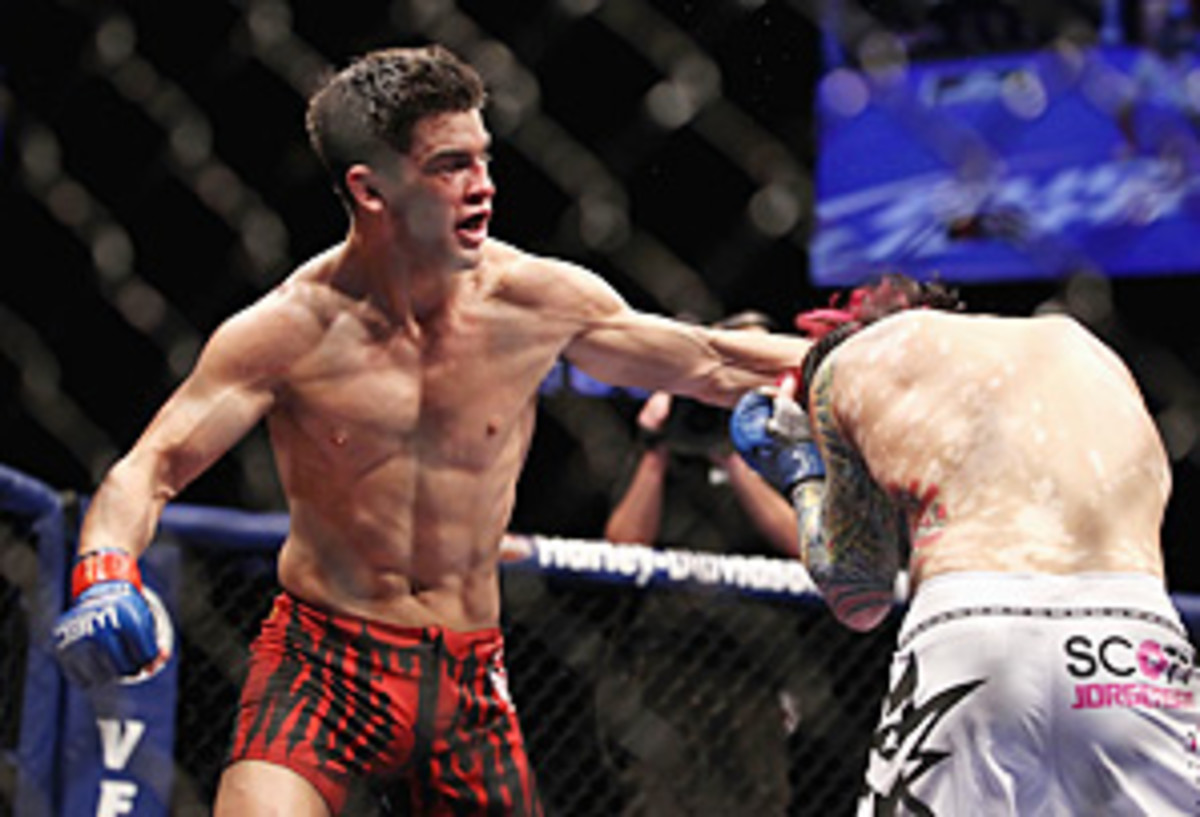UFC's pitch has grown stale


The other day, I was watching a ballgame on television and saw an advertisement for UFC 132. It promised violence.
Tracked, as many UFC promos are, to a corny bit of dated of nü-metal ("Boom! Here comes the boom! Ready or not!"), the ad started with the grim faces of six fighters flashed in quick succession: Ryan Bader, Tito Ortiz, Wanderlei Silva, Chris Leben, Dominick Cruz and Urijah Faber. It then cut to Leben and Silva knocking out hapless victims, Bader and Ortiz throwing bombs, and Cruz and Faber striking from odd angles. Graphics listed the top three fights on the card, followed by a final round of quick cuts of each man posing. In all, this was 31 seconds worth of everything that's wrong with fighting in 2011.
The great obvious problem that UFC has now, more important than intransigent New York politicians or fighters injuring themselves with needlessly tough training, is the difficulty of making new stars. The company's biggest attractions are, in rough order, Brock Lesnar, Georges St-Pierre, Anderson Silva, Quinton Jackson, Forrest Griffin, Rashad Evans, Frank Mir and B.J. Penn. All have been around forever and none is under 30. Most won fame on the first crest of public interest in fighting that followed the debut of The Ultimate Fighter. Of the eight, just one is in his prime.
This is a problem inherent to combat sports, where mass appeal lags and outlasts physical skill by years. Mike Tyson and Chuck Liddell would, if they were to sign bout agreements today, immediately rate among the top drawing cards in their respective sports. The way UFC markets its cards hardly helps, though, and that promo that runs during Chicago White Sox games tells you something about why.
There is nothing haphazard about the way UFC constructs its advertisements. For a card built around a major fight like St-Pierre's title defense against Jake Shields, the promotional materials will usually key in on that one bout and not even mention others. For cards sold on the strength of several fights, the ads will list the bouts in order of how saleable UFC thinks they are. Promos for UFC 126, for instance, listed Anderson Silva's middleweight title defense against Vitor Belfort, Forrest Griffin vs. Rich Franklin, and Bader vs. Jon Jones, in that order.
Fans pick up on these cues, and so you can be sure that even as Cruz's bantamweight title defense goes on last on Sunday, they'll treat the tie-ups between Silva and Leben and Bader and Ortiz as the main events, the fights that won their time and money, the ones that feature real stars.
This is unfortunate. Wanderlei Silva's time as a top fighter ended nearly five years ago when Mirko Filopovic landed a head kick that was -- you knew the moment it landed -- the kind that irrevocably alters a man's life. Chris Leben is a gatekeeper whose appeal is tied up in his status as a former reality television star and his apparent masochism. Tito Ortiz hasn't won a fight against anyone, other than a beyond-shot Ken Shamrock, in more than five years. The only one of the four headliners here with a future at the highest level of the sport is Bader, and watching him throw Ortiz around will tell us nothing we didn't already know about him.
What's nearly as off as the positioning of the fighters is what the ad implies about what matters in a fight. "Pay up to see UFC 132," it more or less says, "and you are guaranteed to see guys swinging at each other's heads, trying to knock one another out. Real men go for blood."
The shame of this is that the sixth of the six men in this ad, Dominick Cruz, is a tactical genius as marketable as any young fighter in the game other than Jon Jones. If Chris Leben's do-or-die-trying artlessness and P.O.D. insisting that the boom is coming play into the worst conceptions of fighting as crass spectacle, Cruz's elusiveness and dense defensive gestures are their exact opposite. Dodging four of five strikes thrown at him behind an incredible screen of quick, peppery combinations -- the man attempted 478 strikes in his last fight! -- Cruz is an artist and the walking antithesis of the idea that MMA is a kind of brute, mindless violence.
If I had to show one man's fights to someone who wanted to understand why I think fights can be beautiful, or to someone who wanted to know what the future of the sport will look like, Cruz would be it. That he comes off as a bit of an afterthought in the marketing of a show he's nominally headlining, and that this marketing does nothing to point up what makes him special, is an enormous missed opportunity for a promotion so reliant on attractions who made their names years ago, in another era.
UFC is very good at marketing, and the criticism here shouldn't be overstated. This Saturday's show is titled "Cruz vs. Faber," not "Silva vs. Leben," and there are good reasons not to sell an entire show on the tricky technical style of a fighter completely unknown to most of the audience. You also have to credit the company enormously for the fact that Cruz is on a UFC card at all. It would have been safe and easy to keep him, Faber, Jose Aldo and the rest of the bantamweights and featherweights isolated in WEC. They aren't.
Still, there are limits to the appeal of watching aging fighters play Rock 'Em Sock 'Em Robots to the stale hits of yesteryear, and limits to how long a promotional strategy that seemed fresh in 2005 will remain so. UFC actually offers up something better. They ought to make sure the public knows it.
Tim Marchman can be reached at tlmarchman@gmail.com.
